Soil formation in temperate climates
PDF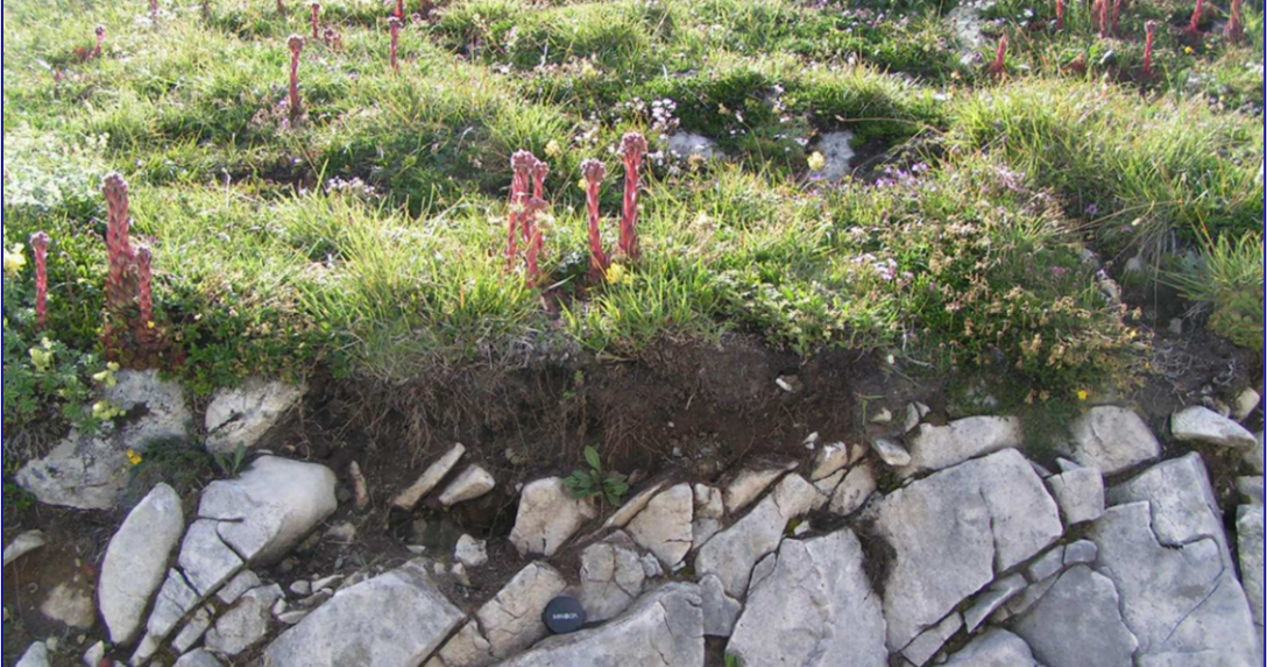
How could rocks be transformed into loose materials that can support rich vegetation? What are the specificities of soils compared to rocks and unaltered formations studied by geology? This article will insist on their organization in aggregates and the presence of a multiform porosity favourable to an intense biological activity as well as to the circulation and storage of water. The formation of soils is the consequence of alterations of various geological materials (the “parent materials” formerly called “mother rocks”), under the action of precipitations and living beings, over a long period of time. A second article will detail the factors that determine their formation, their appearance, their properties and their functioning.
1. What is pedogenesis?
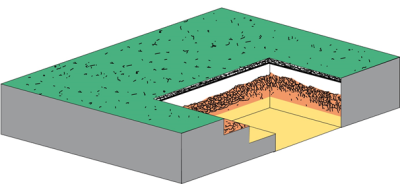
As for pedogenetic processes, they are all the phenomena, natural or linked to human actions, of alterations, neogenesis, transfers, reworking, contributing to the formation and evolution of soils (see below).
To study pedogenesis, to correctly observe the different layers of the soil (called horizons) and to be able to take samples for analyses, it is necessary to dig pits (Figure 1). The use of an auger does not allow for satisfactory observations or adequate sampling. The descriptions on pits must be completed by the interpretation of a whole series of well-chosen analyses, entrusted to competent laboratories.
Today, when we observe a soil in a soil pit, we see the result of the sum of daily, monthly and annual functioning over 1,000, 10,000, 100,000 or 1,000,000 years. Over such long periods of time, there may have been climate changes and/or phases of erosion or new deposits. Soils therefore often have a complex appearance.
The soil that we observe, describe and analyse today is the result of the action of one, but most often several, successive and/or simultaneous pedogenetic processes having acted on an initial material. The morphology and constituents of the soil observed today integrate both the legacy of the parent material and the effects of these different soil forming processes.
Everything that can be observed today (macro- and micromorphological aspects) and analysed (granulometric, chemical and mineralogical analyses) is relative to what has remained in place and is the result of more or less important transformations. These last ones are function of:
- the properties of the initial parent material;
- the time elapsed since the deposit or the exposure of this material;
- the aggressiveness of the successive climates.
But other properties allow us to characterize the present functioning of the soil:
- the pedoclimateAll the temperature and humidity conditions prevailing in the horizons of a soil, which vary during the year, the spontaneous vegetation, the humus formSet of macroscopic morphological characteristics of the upper humus horizons of forest soils (O and A horizons and their succession), depending on their mode of operation, in particular the biological activity they host.;
- the composition of the water flowing down out of the soil and the present water regime;
- current physico-chemical characteristics (pH, state of the Exchange ComplexAll soil constituents likely to retain cations from the soil solution. However, these are only temporarily fixed and remain exchangeable. It is an adsorption, surface phenomenon, without chemical reaction. These constituents are mainly phyllite clay minerals and humified organic matter., etc.).
2. How does a soil differ from a rock?
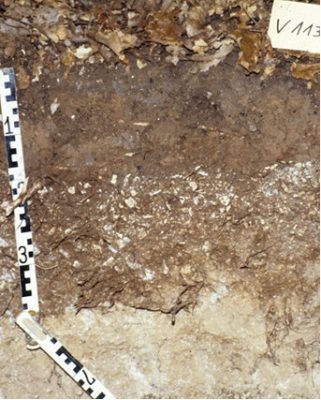
- Chemical transformations of certain minerals: alterations
- Example 1: the relatively rapid disappearance of black micas from granites, and their transformation into clay minerals;
- Example 2: the progressive dissolution of calcite in calcareous soils and sediments (Figure 2).
- The emergence of new mineral species: neogenesis or neoformations.
- Example 1 : the formation of phyllosilicates (clay minerals),
- Example 2 : the formation, from silicate minerals, of free iron oxides, not initially present in the rock,
- The installation and action of living organisms thanks to the relative abundance of oxygen: bacteria, fungi, micro-arthropods, nematodes, earthworms, roots of higher plants, etc.
The result is a specific organization, a macroscopic pedological structure which, in most cases, results in the formation of aggregates. In addition, a large number of voids of various shapes and sizes are formed.
3. Structure and porosity
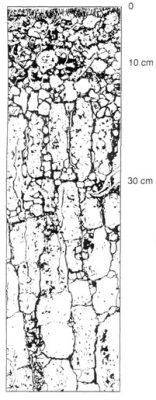
In ploughed surface horizons, regularly reworked by agricultural tools (some break up, others compact), we also speak of structure, but then it is more a question of artificial clods.
Some voids have formed within the aggregates (root holes, interstices between particles, worm channels) and others separate the aggregates (stacking voids, drying cracks).
These voids allow aeration (and therefore the respiration of living organisms) as well as the storage and circulation of water, depending on their shape, size and continuity (or not).
Let’s imagine a heavy rain:
- All or part of the rainwater can run off the surface, even on a very slight slope, if the soil surface is “sealed” by tar, concrete or a slacking crustWhen the surface horizons present very fragile aggregates (as a result of a silt grain size and low organic matter content), a thin crust (0.5 to 5 mm) finely bedded, more or less continuous. This slaking crust hinders the infiltration of water into the soil. This results in the formation of puddles and, often, runoff in the plot, the initial stage of water erosion.;
- A part will circulate vertically under the effect of gravity in the largest voids (> 10 µm), provided that these voids are connected;
- A part will remain in the fine porosity (between 10 and 0.2 µm) but will be able to be extracted and used by the roots of the plants (it is the available reserve);
- Another part is retained in a very fine porosity (< 0.2 µm) by capillary forces so important that water cannot be extracted by the roots;
- Finally, in some cases, water can be blocked at depth by an impermeable layer (e.g. a wet clay layer). The result is a waterlogging of the entire porosity with a short term loss of oxygen and the installation of a reducing environment unfavourable to any aerobic biological activity (microorganisms, roots, earthworms).
4. Biology and pedology: two different worlds, different concepts
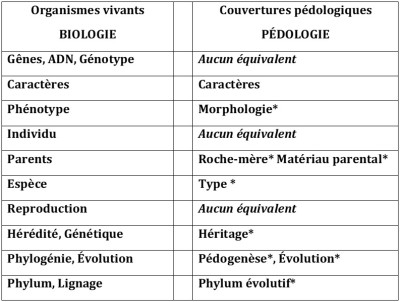
In Figure 4, we have placed a certain number of classical concepts of biology and pedology opposite each other in two columns. Some of the major concepts of biology have no equivalent in pedology! The others have only approximate equivalents indicated by an asterisk *.
Soil and land
A soil is tightly localized and cannot move (unlike air, water, wild animals…). Each soil must therefore be defined by its geographical coordinates. Unlike air and water, it usually has an owner and, often, a farm operator separate from the owner. But it is also a common good that provides irreplaceable ecosystem services to human societies. Conflicts between individual private interests and collective interests are therefore to be expected…
Soil mantles
As the word “soil” is very polysemous and as soils extend over almost all the plains territories, soil scientists now commonly use the notion of soil mantle. Soil mantles are very large volumes of soil forming a continuum that varies in three dimensions of space and evolves with time.
5. The notion of horizon
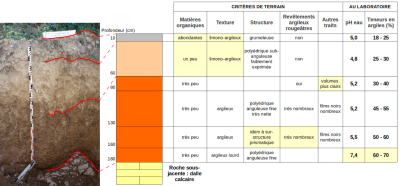
For soil scientists, horizons are the superimposed layers of a soil that have different properties from one another (Figure 5). Indeed, soils generally show differentiations along a vertical axis.
Seen in vertical section, horizons usually appear as horizontal layers of varying thickness. But sometimes their appearance, seen in a vertical trench, is much more complex (Figure 6).
A horizon can be distinguished as soon as a character considered important varies clearly. This division must be reasoned, based on morphological features observed in the field (colours, texture, structure). The limits are not always very clear.
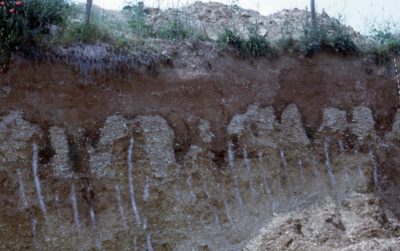
The horizons are the subject of a typology according to their appearance, their functioning and the pedogenetic interpretation that pedologists give them. Codes are associated with this typology: horizons H, O, A, E, -g, S, BT…
6. Soil thicknesses
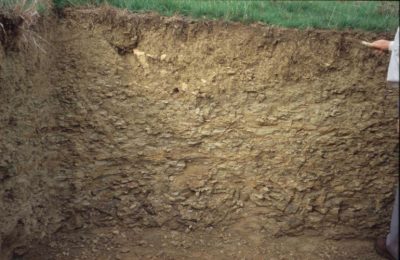
In European climates, “young” soils can be said to have a thickness of between 10/15 cm and 2 m (Figures 8 and 9). But very old soils can reach thicknesses of 10 to 20 metres (e.g., the soils of the Rhodanian stony terraces).
In equatorial or humid intertropical climates of Africa or Brazil, we can consider that the soils, millions of years old, can reach thicknesses between 10 and 25 m.
7. Soil colours
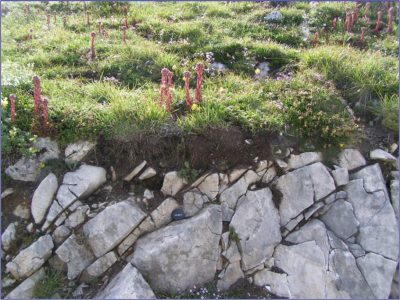
But the colour of the surface horizon cannot provide a sufficient description of essential data (such as texture, structure, thickness, horizon differentiation) nor of chemical characteristics related to potential fertility, nor of functional characters such as water regime.
However, colours are important elements to take into account when describing soils. They guide the soil scientist in distinguishing the different horizons before beginning the systematic description that is carried out horizon by horizon. The colour is not a misleading character: each modification is significant of a change in the proportions of one or several constituents, or of a change in their state of oxidation (case of iron).
The four main colouring agents in soils are:
- iron, through its oxides (in the broad sense): red, orange, purplish, rusty or brown colorations in aerated environments, bluish or greenish in reducing environment;
- organic matter which superimpose black, grey or brown colorations;
- manganese, whose various oxides, more or less associated with iron, are concentrated in certain soil horizons where intense but temporary waterlogging occurs. Nodules, coatings, of black colour are then formed;
- and the lime which gives a white coloration.
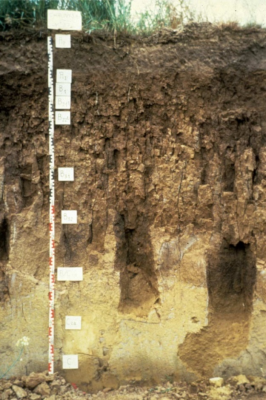
However, a certain number of soils have a colour directly inherited from the material from which they are derived. Examples are the pink soils developed from the pink sandstone of the Vosges or the green soils resulting from the alteration of glaucony grains (Figure 10). For the others, on the contrary, the colour of the different horizons is due to the constituents that have been individualized, accumulated or concentrated during pedogenesis (clays, iron, lime, organic matter).
Soil hues do not usually have agronomic significance, but they can be used by soil scientists to:
- directly recognize the presence, relative abundance, movement or accumulation of the four coloured constituents listed above;
- to note the oxidized or reduced state of the iron which reflects the dynamics of the water through the hydromorphic features related to temporary or permanent waterlogging;
- or detect some particular inherited minerals (glauconyAssociation of clay minerals with a high iron content, belonging to a series of which one pole is of the smectite type and the other of the glauconite type. Formed in the marine environment, it frequently appears in the form of small rounded grains (0.1 to 3 mm) of dark green color. In soils, after moderate weathering, these pseudo-sands disintegrate and provide a green clay material., pink orthosis, etc.).
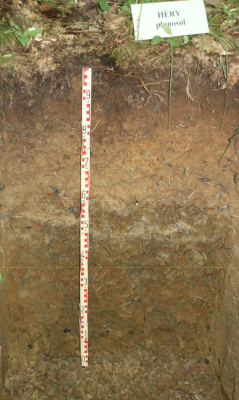
- the nature of the parent material;
- the existence of different pedogenetic processes at the origin of the studied soil, whether these processes are ancient (linked to climates often warmer, responsible for rubefactions (red colour) by release of large quantities of iron oxides) or current;
- certain fertility factors such as the presence and incorporation of organic matter, or on the contrary the risk of toxicity towards certain plants, such as the abundance of fine calcium carbonate, also called “active lime”.
8. Messages to remember
- Soils are formed from rocks but differ from them by a series of characteristics, in particular by the existence of an important porosity whose forms, dimensions and origins are diverse.
- It is this porosity which allows the circulation of air (and water) and makes possible the life and the activity of a whole microfauna as well as the development of the roots of the higher plants. This porosity, of all dimensions, plays an essential role in the storage, filtration and circulation of rainwater.
- In metropolitan France, the thickness of soils is usually between 10 cm and 2 m. But some very old soils can reach 20 m.
Notes and references
[1] Jean Boulaine. (1989) History of soil scientists and soil science. Editions Quae. 285p.
[2] Albert Demolon (1949) La génétique des sols. Éd. Presses Universitaires de France – PUF.
The Encyclopedia of the Environment by the Association des Encyclopédies de l'Environnement et de l'Énergie (www.a3e.fr), contractually linked to the University of Grenoble Alpes and Grenoble INP, and sponsored by the French Academy of Sciences.
To cite this article: BAIZE Denis (June 21, 2023), Soil formation in temperate climates, Encyclopedia of the Environment, Accessed July 27, 2024 [online ISSN 2555-0950] url : https://www.encyclopedie-environnement.org/en/soil/soil-formation-temperate-climates/.
The articles in the Encyclopedia of the Environment are made available under the terms of the Creative Commons BY-NC-SA license, which authorizes reproduction subject to: citing the source, not making commercial use of them, sharing identical initial conditions, reproducing at each reuse or distribution the mention of this Creative Commons BY-NC-SA license.




